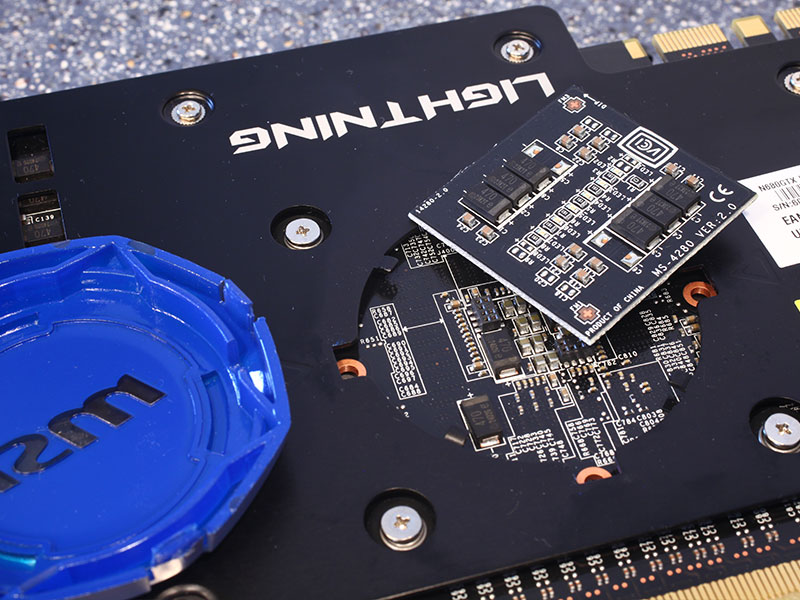MSI launched its fastest custom-design GeForce GTX 680 graphics card, the N680GTX Lightning. The card is armed with unlocked digital power VRM, TwinFrozr IV cooling solution, factory-overclocked frequencies, in a package that doesn't need more than two expansion card slots in your system.The N680GTX Lightning from MSI combines a custom design PCB with focus on a high-grade VRM, with its TwinFrozr IV cooling solution, of similar specifications to the one used on the R7970 Lightning. The PCB uses an 8+3 phase VRM design that draws power from two 8-pin PCIe power connectors; uses a CHiL-made VRM controller with software interface for Afterburner; and high-grade components that include SFC chokes (don't whine on load), and International Rectifier DirectFETs. MSI includes its GPU Reactor module, which conditions power for the GPU.The N680GTX Lightning comes with out-of-the-box clock speeds of 1100 MHz (GPU base), 1176 MHz (GPU Boost), although the memory is left untouched, at 1502/6008 MHz (actual/effective). The GPU is armed with 2 GB of GDDR5 memory, across a 256-bit wide memory interface.Cooling the beast is MSI's in-house design TwinFrozr IV cooling solution, which made its debut with the Radeon HD 7970-based R7970 Lightning. The cooler, along with the PCB and its lavish VRM, make the card taller than usual, although it avoids needing more than two expansion slots in your system. The cooler uses a dense aluminum fin array, to which heat from the GPU is fed by five nickel-plated copper heat pipes (three 6 mm-thick, and two 8 mm-thick), which make indirect contact with the GPU over a nickel-plated copper base. The aluminum fin array is then ventilated by two 100 mm MSI PropellerBlade fans. MSI claims the solution keeps the card 16 degrees cooler and 6.7dB quieter than NVIDIA reference design cooler. The memory and VRM are cooled by a separate heatspreader, which is cooled under the fans' air-flow. There are DirectFETs even on the reverse side of the PCB, which are cooled by a metal back-plate.MSI promises additional overclocking potential thanks to the strong VRM and its Afterburner software, which can leverage on the CHiL VRM controller's capabilities. A couple of nifty overclocker friendly features are part of the mix, including dual-BIOS with a liquid nitrogen cooling-optimized BIOS, and a standard BIOS that packs the advertised clock speeds; and 3x3 OC Kits for real-time monitoring and control of the GPU, PLL, and memory voltage domains, and monitoring of temperature zones.MSI is expected to price the N680GTX Lightning somewhere around US $580 (S$734).
Read more: MSI GeForce GTX 680 Lightning Launched by VR-Zone.com
Results 1 to 8 of 8
-
06-21-2012, 10:33 AM #1
 MSI GeForce GTX 680 Lightning Launched
MSI GeForce GTX 680 Lightning Launched
-
06-21-2012, 12:15 PM #2
 Re: MSI GeForce GTX 680 Lightning Launched
Re: MSI GeForce GTX 680 Lightning Launched
naa xa backplate boss?
-
06-21-2012, 12:24 PM #3
-
06-21-2012, 12:25 PM #4
 Re: MSI GeForce GTX 680 Lightning Launched
Re: MSI GeForce GTX 680 Lightning Launched

-
06-21-2012, 12:29 PM #5
 Re: MSI GeForce GTX 680 Lightning Launched
Re: MSI GeForce GTX 680 Lightning Launched
thanks boss

hehe suya2 lang ko lol
-
06-21-2012, 10:18 PM #6C.I.A.

- Join Date
- Jul 2010
- Gender

- Posts
- 2,847
-
06-21-2012, 10:56 PM #7Senior Member

- Join Date
- Aug 2007
- Gender

- Posts
- 550
 Re: MSI GeForce GTX 680 Lightning Launched
Re: MSI GeForce GTX 680 Lightning Launched
palit ta ani! baligya usa ka kidney. toink!
-
06-22-2012, 08:07 AM #8
 Re: MSI GeForce GTX 680 Lightning Launched
Re: MSI GeForce GTX 680 Lightning Launched
nindota oi.. igo ra tawn ko patulo sa laway.. haha
Advertisement
Similar Threads |
|










 Reply With Quote
Reply With Quote


